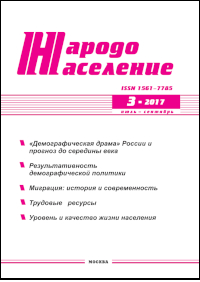Подходы к совершенствованию региональной политики в сфере охраны здоровья населения
Выражение признательности
исследование выполнено при финансовой поддержке РФФИгрант № 16-36-00181 мол_а
Для цитирования
Шибалков И. П. Подходы к совершенствованию региональной политики в сфере охраны здоровья населения // Народонаселение. 2017. Том 20. № 3. С. 144-158.
Аннотация
Существенная дифференциация социально-экономического положения субъектов РФ свидетельствует о значительных региональных различиях в условиях демографического развития. Анализ социально-экономических показателей позволяет говорить о существовании различных моделей формирования здоровья населения на той или иной территории. Факторный анализ социально-экономической ситуации в регионах России с последующей кластеризацией на основе 22 статистических показателей позволил провести типологизацию регионов по уровню состояния здоровья населения и социально-экономического развития и выработать подходы к совершенствованию политики в сфере охраны здоровья населения для каждой группы субъектов РФ. Регионы страны разделены на четыре группы, для каждой из которых сформулированы рекомендации по увеличению ожидаемой продолжительности жизни. Обоснована необходимость признания проблемы неравенства в здоровье на федеральном уровне.
Ключевые слова:
продолжительность жизни, региональная дифференциация, смертность, демографическая политика, региональная политика
Литература
Charlton J.R., Velez R. Some international comparisons of mortality amenable to medical intervention. BMJ. — 1986. — No. 292. — P. 295–301.
Михайлова Ю.В., Иванова А.Е. Предотвратимая смертность в России и пути её сни-жения. — М.: РИО ЦНИИОИЗ, 2006. — 308 с.
Сабгайда Т.П. Возрастные особенности предотвратимой смертности населения Рос-сии // Социальные аспекты здоровья населения. — 2013. — Т. 33 — № 5. — Режим доступа: https://elibrary.ru/download/elibrary_20616011_56530892.pdf
Рязанцев С.В., Иванова А.Е., Гришин А.С. Методика оценки предотвратимой смертности населения: территориальный и исторический подходы // Научное обо-зрение. Серия 1. Экономика и право. — 2013. — № 6. — С. 69-76.
Продлевая жизнь: доклад Исследовательского центра ИТАР-ТАСС при содействии экспертов Центра социальной экономки. — М., 2014.
Аганбегян А. Уменье не упасть числом // Эксперт. — 2014. — № 28 (907).
Рязанцев С.В., Храмова М.Н., Гришин А.С. Социальные резервы демографического развития России в современных условиях: определение, компоненты, факторы // Научное обозрение. Серия 2. Гуманитарные науки. — 2016. — № 6. — С. 33-46.
Немцов А.В. Алкогольная смертность в России и пути снижения алкогольных потерь // Демографические перспективы России и задачи демографической политики: материалы научно-практической конференции (6-8 апреля 2010 г.). — М.: Экон-Информ, 2010. — С. 66-74.
Иванова А.Е., Рязанцев С.В., Семенова В.Г. Вклад миграции в смертность российского населения трудоспособного возраста // Научное обозрение. Серия 2. Гуманитарные науки. — 2016. — № 6. — С. 47-60.
Пономарев В. Магнит для иностранцев // Expert Online. — 2013. — [Электронный ресурс] — Режим доступа: http://expert.ru/2013/01/29/magnit-dlya-inostrantsev/ (дата обращения: 28.03.2017).
Юмагузин В. В. Матрица Хэддона как инструмент снижения смертности от внеш-них причин / XV апрельская международная научная конференция по проблемам развития экономики и общества: в 4-х книгах. — М.: ИД НИУ ВШЭ, 2015. — Кн.3 — С. 92-101.
Рыбаковский Л.Л. Демографический потенциал Дальнего Востока, его динамика и качество. — [Электронный ресурс] — Режим доступа: http://rybakovsky.ru/ naseleniereg1.html (дата обращения: 28.03.2017).
Кислицына О.А. Неравенство в распределении доходов и здоровья в современной России. — М.: РИЦ ИСЭПН, 2005. — 376 с.
Социальные и гендерные неравенства в отношении окружающей среды и здоровья. Всемирная Организация Здравоохранения, 2010. — 23 с.
Кучерявенко О., Ухова Д. Неравенство и доступ к здравоохранению в России — [Электронный ресурс] — Режим доступа: http://neravenstvo.com/?p=865 (дата об-ращения: 28.03.2017).
Phelan J. C., Link B. G., Tehranifar P. Social conditions as fundamental causes of health inequalities: Theory, evidence and policy implications. Journal of Health and Social Behavior. 2010. Vol. 51. P. 28-40.
Михайлова Ю.В., Иванова А.Е. Предотвратимая смертность в России и пути её сни-жения. — М.: РИО ЦНИИОИЗ, 2006. — 308 с.
Сабгайда Т.П. Возрастные особенности предотвратимой смертности населения Рос-сии // Социальные аспекты здоровья населения. — 2013. — Т. 33 — № 5. — Режим доступа: https://elibrary.ru/download/elibrary_20616011_56530892.pdf
Рязанцев С.В., Иванова А.Е., Гришин А.С. Методика оценки предотвратимой смертности населения: территориальный и исторический подходы // Научное обо-зрение. Серия 1. Экономика и право. — 2013. — № 6. — С. 69-76.
Продлевая жизнь: доклад Исследовательского центра ИТАР-ТАСС при содействии экспертов Центра социальной экономки. — М., 2014.
Аганбегян А. Уменье не упасть числом // Эксперт. — 2014. — № 28 (907).
Рязанцев С.В., Храмова М.Н., Гришин А.С. Социальные резервы демографического развития России в современных условиях: определение, компоненты, факторы // Научное обозрение. Серия 2. Гуманитарные науки. — 2016. — № 6. — С. 33-46.
Немцов А.В. Алкогольная смертность в России и пути снижения алкогольных потерь // Демографические перспективы России и задачи демографической политики: материалы научно-практической конференции (6-8 апреля 2010 г.). — М.: Экон-Информ, 2010. — С. 66-74.
Иванова А.Е., Рязанцев С.В., Семенова В.Г. Вклад миграции в смертность российского населения трудоспособного возраста // Научное обозрение. Серия 2. Гуманитарные науки. — 2016. — № 6. — С. 47-60.
Пономарев В. Магнит для иностранцев // Expert Online. — 2013. — [Электронный ресурс] — Режим доступа: http://expert.ru/2013/01/29/magnit-dlya-inostrantsev/ (дата обращения: 28.03.2017).
Юмагузин В. В. Матрица Хэддона как инструмент снижения смертности от внеш-них причин / XV апрельская международная научная конференция по проблемам развития экономики и общества: в 4-х книгах. — М.: ИД НИУ ВШЭ, 2015. — Кн.3 — С. 92-101.
Рыбаковский Л.Л. Демографический потенциал Дальнего Востока, его динамика и качество. — [Электронный ресурс] — Режим доступа: http://rybakovsky.ru/ naseleniereg1.html (дата обращения: 28.03.2017).
Кислицына О.А. Неравенство в распределении доходов и здоровья в современной России. — М.: РИЦ ИСЭПН, 2005. — 376 с.
Социальные и гендерные неравенства в отношении окружающей среды и здоровья. Всемирная Организация Здравоохранения, 2010. — 23 с.
Кучерявенко О., Ухова Д. Неравенство и доступ к здравоохранению в России — [Электронный ресурс] — Режим доступа: http://neravenstvo.com/?p=865 (дата об-ращения: 28.03.2017).
Phelan J. C., Link B. G., Tehranifar P. Social conditions as fundamental causes of health inequalities: Theory, evidence and policy implications. Journal of Health and Social Behavior. 2010. Vol. 51. P. 28-40.
Форматы цитирования
Другие форматы цитирования:
APA
Шибалков, И. П. (2017). Подходы к совершенствованию региональной политики в сфере охраны здоровья населения. Народонаселение, 20(3), 144-158. извлечено от https://www.jour.fnisc.ru/index.php/population/article/view/6560
Раздел
УРОВЕНЬ И КАЧЕСТВО ЖИЗНИ








